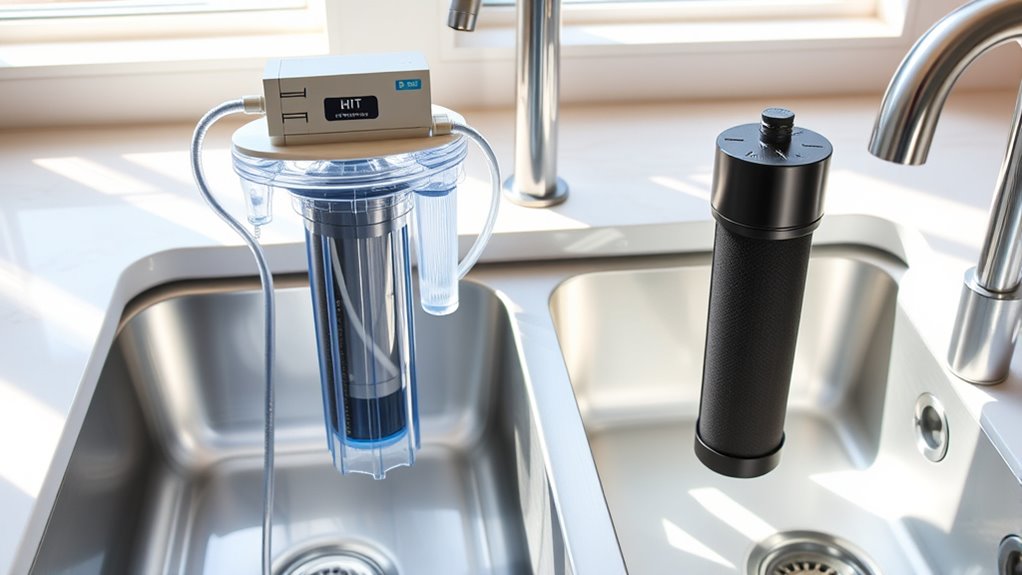Reverse osmosis systems use high pressure to force water through a semi-permeable membrane, removing over 97% of contaminants, heavy metals, and microbes, but can waste water and strip minerals, making water taste flat. Carbon filters trap chlorine, organic compounds, and some metals, improving taste and odor with minimal waste. If you want thorough purity, RO is ideal, but for cost-effective, eco-friendly filtration, carbon is a good choice. Keep exploring to find the best fit for your needs.
Key Takeaways
- Reverse osmosis provides more comprehensive contaminant removal, including dissolved salts, microbes, and heavy metals, compared to carbon filters.
- Carbon filters improve taste and odor by removing chlorine and organic compounds but do not effectively remove dissolved solids or microbes.
- RO systems tend to waste more water and require professional installation, while carbon filters are easier to install and more eco-friendly.
- Reverse osmosis produces flatter, less mineralized water, often needing remineralization stages, whereas carbon filters preserve minerals in water.
- Overall, RO is ideal for high TDS and microbial contamination, while carbon filters suit municipal water with chlorine and organic pollutants.
How Reverse Osmosis Systems Operate

Reverse osmosis systems work by applying high pressure—typically between 800 and 1000 psi—to force water through a semi-permeable membrane. This membrane acts as a barrier, allowing only pure water molecules to pass while blocking contaminants and impurities. The pressure pushes water through multiple stages of filtration, including pre-filters that remove sediment and other larger particles. As water moves through the semi-permeable membrane, dissolved solids, heavy metals, bacteria, viruses, and chemicals like chlorine are separated out. The purified water then flows to the outlet, while waste brine containing concentrated impurities is expelled. Power sources such as household water pressure or an additional pump provide the necessary force. Regular maintenance, including replacing filters and membranes, guarantees the system continues to effectively reduce contaminants. Proper maintenance ensures the system’s longevity and contaminant removal efficiency. Additionally, understanding the industry transformations related to filtration technology can help consumers choose the most effective system for their needs. Incorporating advanced filtration techniques can further enhance water purity and system performance.
The Mechanism Behind Activated Carbon Filters
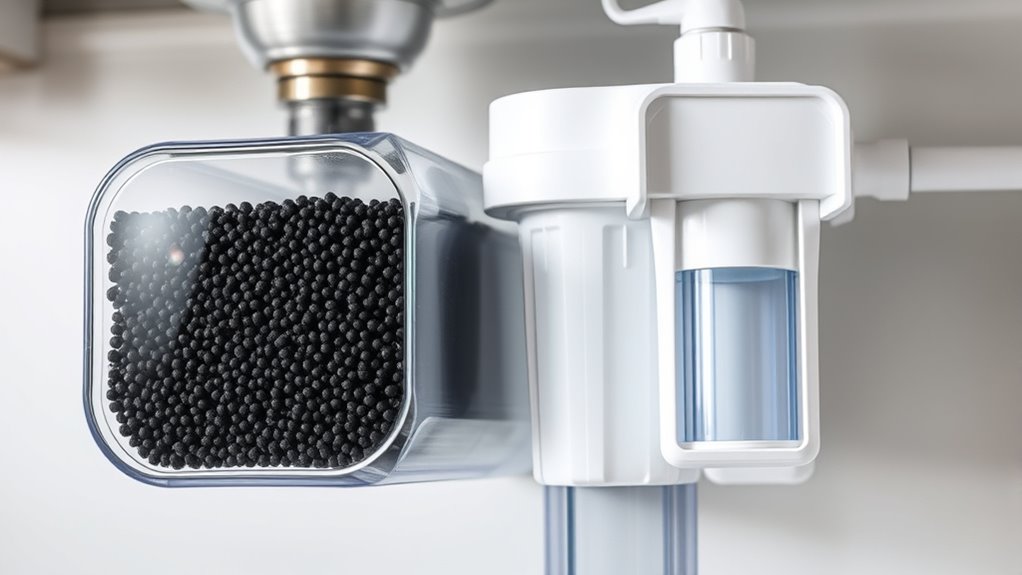
Activated carbon filters work by attracting and trapping contaminants on their porous surfaces through a process called adsorption. When water passes through the filter, activated carbon’s high surface area captures pollutants like chlorine, organic compounds, and some heavy metals. The effectiveness depends on pore sizes, which range from micro- to mesopores, allowing removal of particles as small as 0.5 microns. As contaminants adhere to the carbon surface, the filter’s capacity diminishes, making filter replacement necessary to maintain performance. The surface attraction relies on chemical bonds formed during adsorption, ensuring contaminants stay trapped. To keep your system functioning best, monitor for saturation and replace the filter regularly. Understanding this mechanism helps you appreciate how activated carbon improves water taste and odor. Additionally, ongoing research into AI safety and monitoring techniques highlights the importance of robust safety measures to prevent vulnerabilities and ensure trustworthy performance of filtration systems. Maintaining proper filter maintenance practices is essential to maximize efficiency and extend the lifespan of your filtration system. Regularly checking the filter’s capacity can help prevent breakthrough of contaminants and ensure optimal water quality. This ongoing innovation in filtration technology underscores the importance of staying informed about advances in water treatment.
Effectiveness in Removing Contaminants
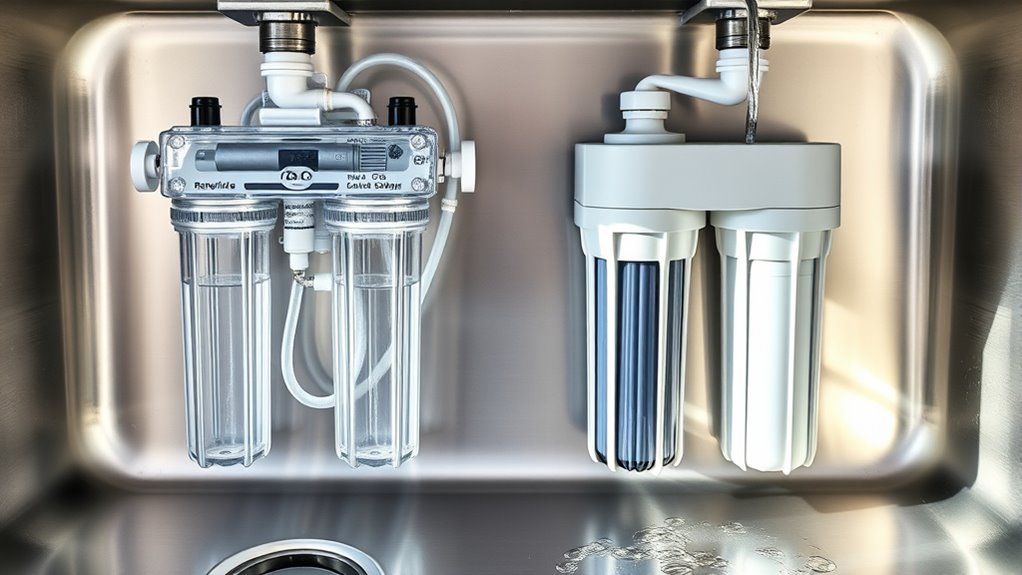
When it comes to removing contaminants from water, different filtration methods offer varying degrees of effectiveness. Reverse osmosis systems excel in contaminant removal, filtering down to 0.001 microns and removing over 97% of dissolved solids, heavy metals, bacteria, and viruses. They effectively eliminate contaminants like arsenic, fluoride, nitrates, and pharmaceuticals, providing a high level of purification for heavily contaminated water sources. In contrast, carbon filters mainly target chlorine, VOCs, and some metals, removing particles larger than 0.5-1 micron and improving taste and odor. While carbon filters handle many organic compounds, they’re limited in removing dissolved inorganic contaminants like arsenic and fluoride. Combining reverse osmosis with carbon filtration maximizes filtration effectiveness, offering the most exhaustive removal of a broad spectrum of contaminants.
Impact on Water Taste and Odor
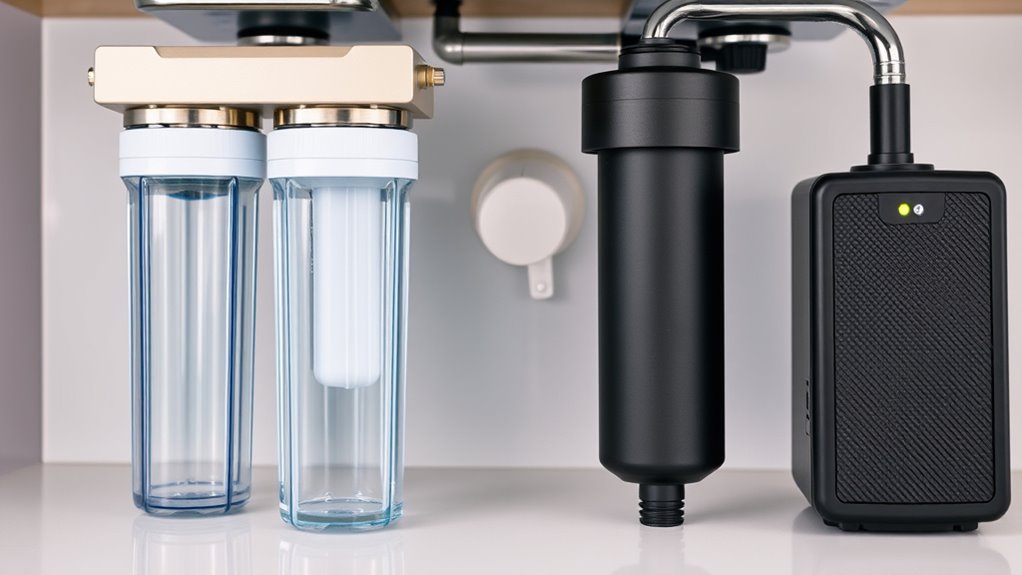
You’ll notice that carbon filters often improve water’s taste and smell by removing chlorine and other chemicals, making it more appealing for drinking. In contrast, reverse osmosis tends to produce water with a neutral or flat flavor since it removes minerals that add natural taste. Combining both systems can give you the best of both worlds—clean, fresh-tasting water free of odors. Proper installation and maintenance are essential to ensure optimal performance and safety of these filtration systems. Additionally, understanding the filter lifespan can help you maintain water quality over time. Regularly replacing filters and monitoring system performance are key to maintaining the water quality and ensuring your system functions effectively. Considering filter types and their specific functions can help tailor your system to your needs.
Flavor Enhancement Differences
Have you noticed how different filtration methods impact the taste and smell of your water? Reverse osmosis systems tend to strip out minerals that give water its natural flavor, often leaving a flatter, less mineralized taste. Without these minerals, the water can feel dull or metallic. Some RO units include remineralization stages to restore desirable minerals, improving flavor and mouthfeel. On the other hand, activated carbon filters excel at removing chlorine and organic compounds that cause odors, greatly enhancing aroma and taste. They’re also effective at eliminating sulfur compounds that produce rotten egg smells. While carbon filters preserve minerals, they may not remove salts or dissolved substances that could cause skunky or off-putting flavors. Interestingly, the mineral content in water plays a significant role in its overall flavor profile and health benefits. Additionally, understanding the different removal capabilities of each system can help you choose the best option for your taste preferences. Furthermore, knowing how each system affects water mineralization can guide you in selecting a filtration method that aligns with your health and flavor expectations.
Moreover, the choice of filtration system can also influence the long-term maintenance and overall cost, which are important considerations for consumers. Overall, each system influences flavor and odor differently based on its removal capabilities.
Odor Removal Effectiveness
Activated carbon filters are highly effective at quickly removing odors and improving water taste by adsorbing volatile organic compounds (VOCs) and chlorine, which are the main culprits behind unpleasant smells. They considerably enhance water aroma and flavor within minutes of filtration. These filters can eliminate over 99% of chlorine and many VOCs, making your water taste fresher and odors less noticeable. The rapid action of activated carbon filters contributes to their popularity for immediate odor removal. Reverse osmosis systems also improve water odor and taste by removing a broader range of contaminants, including dissolved chemicals that cause persistent or chemical odors. However, they may leave residual mineral flavors due to partial mineral retention, resulting in a slightly different water taste. The effectiveness of either system depends on filter quality and contact time, with activated carbon generally providing quicker, more noticeable odor removal. Additionally, contrast ratio plays a role in assessing water clarity and quality, impacting the overall perception of water purity.
Water Usage and Environmental Considerations
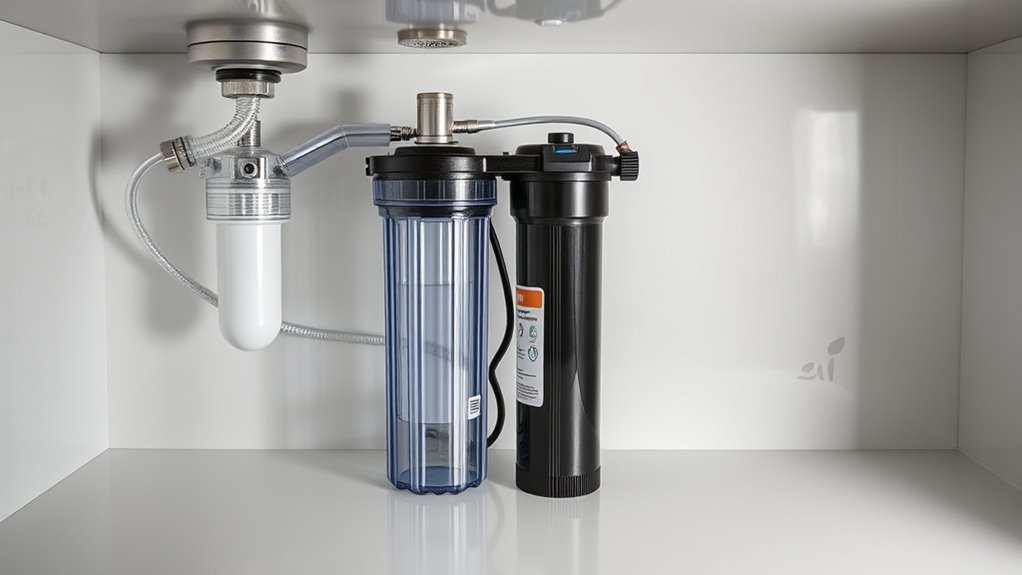
When comparing water usage and environmental impact, reverse osmosis systems stand out for their high water waste, typically discarding 2-3 gallons for every gallon of purified water. This significant water waste increases overall water consumption and can strain local resources, especially in areas with limited water availability. The environmental impact is also heightened by the higher energy use needed to push water through the membrane, reducing energy efficiency. In contrast, activated carbon filters don’t waste water during operation, making them a more water-saving and eco-friendly option. To lessen the environmental footprint of RO systems, you can choose models with water-saving features or incorporate wastewater recovery. Additionally, understanding water filtration methods can help you select the most sustainable system for your needs. Incorporating water conservation practices can further minimize your environmental impact and promote sustainable water use. For example, selecting systems with energy-efficient components can help reduce overall energy consumption. Being aware of water waste factors allows consumers to make more informed choices about their water treatment options. Recognizing system maintenance requirements can also help ensure optimal performance and longevity of your water filter. Balancing water waste with purification needs helps you make more sustainable choices.
Installation and Maintenance Requirements
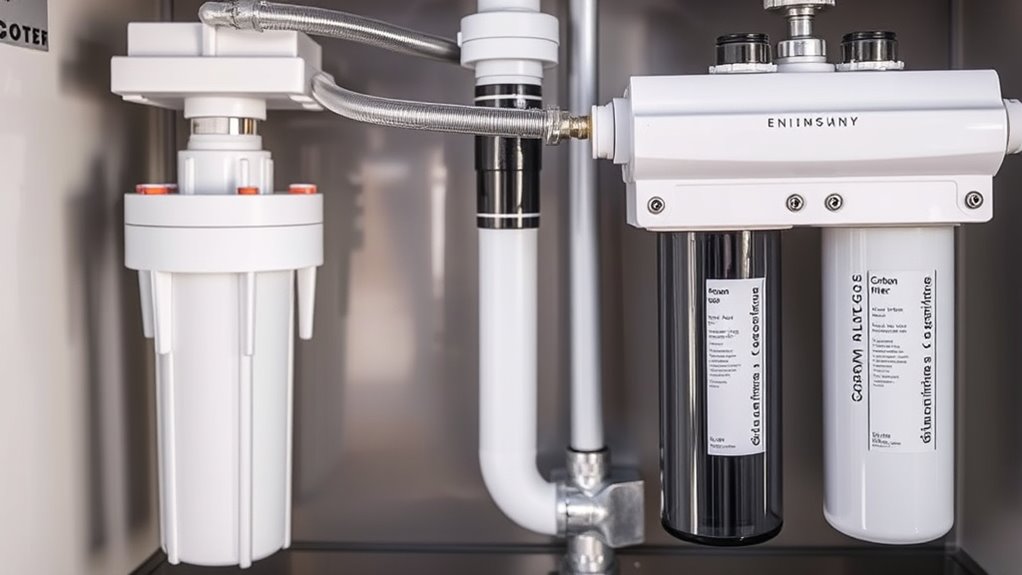
Installing a reverse osmosis system usually involves professional help due to its complex plumbing and extra components, while carbon filters are quick and easy to set up yourself. RO units also require more frequent filter and membrane replacements, increasing ongoing maintenance costs, whereas carbon filters need changing every few months. Consider how much space and time you’re willing to dedicate, as RO systems take up more room and effort compared to the minimal maintenance of carbon filters.
Installation Complexity and Cost
Reverse osmosis (RO) systems generally require professional installation because of their complex plumbing, multiple components, and connection to the home’s water supply and drain line. This makes the installation process more involved and costly compared to simple DIY setups. The initial cost for an RO system, including installation, ranges from $200 to over $600, whereas basic carbon filters often cost less than $150 to purchase and install. Installing an RO system involves connecting to the water supply, drain line, and storage tank, which adds to the complexity. Maintenance includes regular filter replacements and occasional professional troubleshooting, increasing ongoing costs. In contrast, carbon filters are more straightforward, usually requiring minimal technical skills for installation and maintenance.
- Complex plumbing requiring professional installation
- Higher initial cost for RO systems
- Connection to water supply, drain, and tank
- Ongoing costs for maintenance and professional help
- DIY options are easier with carbon filters
Filter Replacement Frequency
The frequency of filter replacements considerably affects both the maintenance effort and ongoing costs of your water filtration system. For reverse osmosis systems, you’ll need to replace filters every 6 to 12 months, depending on water quality and usage levels. RO membranes last longer, typically 2 to 3 years, but still require periodic replacement or cleaning to maintain system performance. Carbon filters in under-sink systems generally need replacing every 3 to 6 months to guarantee optimal water quality. Regular system maintenance, including timely filter replacement, is vital to prevent damage and preserve filtration effectiveness. Neglecting these tasks can lead to decreased water quality and higher long-term costs, especially in systems with more complex filters like RO units.
Cost Analysis Over Time

Over time, the total costs of water filtration systems can vary considerably depending on the type you choose. Reverse osmosis systems have higher initial costs, around $200–$600, but their filter replacements are less frequent, reducing ongoing expenses. In contrast, carbon filters are cheaper upfront, costing about $125–$300, but require more frequent replacements, increasing ongoing expenses. Over five years, the total cost for an RO system can range from $500 to over $1,000, while carbon filters typically total $400–$700. Maintenance costs also differ, with RO systems often requiring more complex and costly upkeep. Water wastage in RO adds to operational costs, especially in high water bill areas.
Water filtration costs vary by system type, with RO being more expensive initially but cheaper long-term.
- Initial costs vary substantially
- Filter replacements impact ongoing expenses
- Maintenance costs are higher for RO
- Total cost depends on lifespan and usage
- Water wastage influences operational costs
Ideal Water Quality Conditions for Each System

Understanding the water quality conditions that suit each filtration system can help you choose the right one for your needs. Reverse osmosis systems excel in areas with high TDS levels, heavy metals, and contaminants like arsenic or fluoride, providing near-total purification. They are ideal if your water contains significant dissolved solids or microbial threats, such as bacteria and viruses. Activated carbon filters are best for municipalities with chlorinated water, as they effectively remove chlorine, VOCs, and improve taste and odor. If your water has moderate or low TDS, like well water with minimal salts, carbon filters usually suffice for safe drinking water. For specific chemical pollutants or high mineral content, combining RO with carbon filtration offers extensive removal, ensuring excellent water quality tailored to your source.
Benefits and Limitations of Each Technology
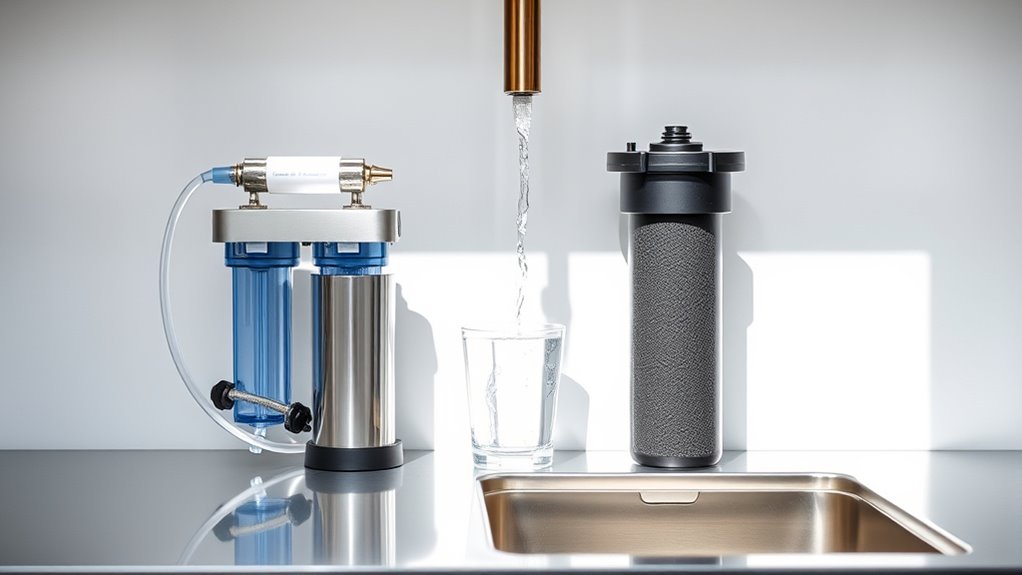
Both reverse osmosis and carbon filters offer distinct advantages and drawbacks based on their filtration capabilities and environmental impact. While RO systems provide all-encompassing removal of tiny particles and contaminants, they generate waste and require more maintenance. Meanwhile, carbon filters are simpler and cheaper but don’t eliminate dissolved salts or microbes as effectively.
Filtration Effectiveness Range
When comparing filtration effectiveness, reverse osmosis and carbon filters each have distinct strengths and limitations. Reverse osmosis systems have a higher filtration capacity, capable of removing particles as small as 0.001 microns, which allows for superior dissolved solids and contaminant removal. They markedly reduce TDS levels, often below 100 ppm, and eliminate viruses, heavy metals, and pharmaceuticals. In contrast, carbon filters target larger particles, typically 0.5-1 micron, removing about 85% of particles and excel at removing chlorine, VOCs, and organic compounds. However, their limited filtration capacity means they can’t reliably remove dissolved salts or microbes. Overall, reverse osmosis offers a broader range of contaminant removal, while carbon filters are better for taste and odor improvements in cleaner water sources.
- Particle size filtration range
- Dissolved solids removal effectiveness
- Contaminant removal spectrum
- TDS reduction capabilities
- Filtration capacity limitations
Environmental and Maintenance Impact
Reverse osmosis systems, while highly effective at removing a wide range of contaminants, tend to have a significant environmental footprint due to their high water waste and energy consumption. You’ll notice about 2-3 gallons of water are wasted per gallon purified, increasing water usage and environmental impact. Maintenance costs can add up, as filters and membranes need replacement every 6 to 12 months, creating waste and ongoing expenses. In contrast, carbon filters have a longer filter lifespan, typically lasting 3 to 6 months, with minimal maintenance and waste. They operate passively, consuming negligible energy, making them more eco-friendly. Overall, while RO systems excel in purification, their environmental and maintenance impact is considerably higher than that of carbon filters.
Choosing the Right System for Your Needs

Choosing the right water filtration system depends on your specific water quality and your priorities. If your water contains heavy metals, dissolved solids, or pathogens, reverse osmosis offers superior contaminant removal and high water quality. For cleaner water with better taste and odor, carbon filters are cost-effective and easy to maintain. Consider your budget, maintenance preferences, and the level of filtration needed.
- Heavily polluted water requires reverse osmosis
- Cleaner, taste-focused water suits carbon filters
- Higher initial cost for RO, lower for carbon filters
- Regular maintenance for RO, simple for carbon
- Prioritize contaminant removal or aesthetic improvements
Assess your water source carefully to choose a system that meets your needs efficiently.
Frequently Asked Questions
Is Reverse Osmosis Better Than Carbon Filter?
You want to know if reverse osmosis is better than a carbon filter. Generally, yes, because RO removes up to 97% of contaminants, including viruses, bacteria, and heavy metals, providing cleaner, safer water. Carbon filters mainly improve taste and odor by removing chlorine and organic compounds but don’t eliminate as many harmful substances. So, if you need thorough purification, reverse osmosis is the superior choice for your water quality.
What Is the Best Undersink Filter System?
You’re probably wondering which under-sink filter system is best. Did you know that reverse osmosis removes over 97% of contaminants, making it ideal for heavily polluted water? If your water’s relatively clean and you mainly want better taste and odor, a carbon filter is a cost-effective choice. Consider your water quality needs and budget—RO is thorough but pricier, while carbon filters are simpler and eco-friendly.
What Are the Disadvantages of Carbon Filters?
You should know that carbon filters have some downsides. They can’t remove dissolved minerals like lead, arsenic, or fluoride, so your water may still contain harmful substances. They also don’t target viruses or bacteria unless paired with other filters. Over time, they can clog and lose effectiveness if you don’t replace them regularly. Plus, they mainly improve taste and smell, not the overall purity of your water.
Is There Anything Better Than Reverse Osmosis?
You might think nothing beats reverse osmosis, but emerging technologies are changing the game. Advanced systems like nanofiltration and multi-stage filters combine carbon and other media to match or surpass RO’s purity—without wasting water or energy. They’re like a superhero upgrade for your water quality, tackling contaminants more efficiently. So yes, there are options that can be better, especially if you want top-tier purity with less environmental impact.
Conclusion
Choosing between reverse osmosis and carbon filters is like picking the perfect puzzle piece—you gotta find what fits your water needs best. While RO systems excel at removing impurities, carbon filters shine in improving taste and odor. Think about your priorities and water quality to make the right call. Whichever you choose, you’re taking a confident step toward cleaner, better-tasting water—your home’s own secret weapon against impurities.
